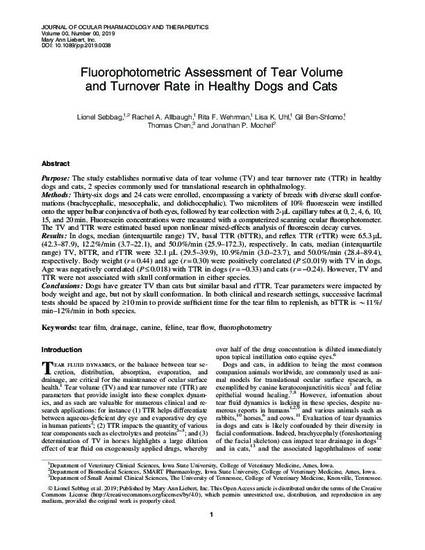
Purpose: The study establishes normative data of tear volume (TV) and tear turnover rate (TTR) in healthy dogs and cats, 2 species commonly used for translational research in ophthalmology.
Methods: Thirty-six dogs and 24 cats were enrolled, encompassing a variety of breeds with diverse skull conformations (brachycephalic, mesocephalic, and dolichocephalic). Two microliters of 10% fluorescein were instilled onto the upper bulbar conjunctiva of both eyes, followed by tear collection with 2-μL capillary tubes at 0, 2, 4, 6, 10, 15, and 20 min. Fluorescein concentrations were measured with a computerized scanning ocular fluorophotometer. The TV and TTR were estimated based upon nonlinear mixed-effects analysis of fluorescein decay curves.
Results: In dogs, median (interquartile range) TV, basal TTR (bTTR), and reflex TTR (rTTR) were 65.3 μL (42.3–87.9), 12.2%/min (3.7–22.1), and 50.0%/min (25.9–172.3), respectively. In cats, median (interquartile range) TV, bTTR, and rTTR were 32.1 μL (29.5–39.9), 10.9%/min (3.0–23.7), and 50.0%/min (28.4–89.4), respectively. Body weight (r = 0.44) and age (r = 0.30) were positively correlated (P ≤ 0.019) with TV in dogs. Age was negatively correlated (P ≤ 0.018) with TTR in dogs (r = −0.33) and cats (r = −0.24). However, TV and TTR were not associated with skull conformation in either species.
Conclusions: Dogs have greater TV than cats but similar basal and rTTR. Tear parameters were impacted by body weight and age, but not by skull conformation. In both clinical and research settings, successive lacrimal tests should be spaced by ≥10 min to provide sufficient time for the tear film to replenish, as bTTR is ∼11%/min–12%/min in both species.
Available at: http://works.bepress.com/jonathan-mochel/59/

This article is published as Sebbag, Lionel, Rachel A. Allbaugh, Rita F. Wehrman, Lisa K. Uhl, Gil Ben-Shlomo, Thomas Chen, and Jonathan P. Mochel. "Fluorophotometric Assessment of Tear Volume and Turnover Rate in Healthy Dogs and Cats." Journal of Ocular Pharmacology and Therapeutics (2019). DOI: 10.1089/jop.2019.0038. Posted with permission.